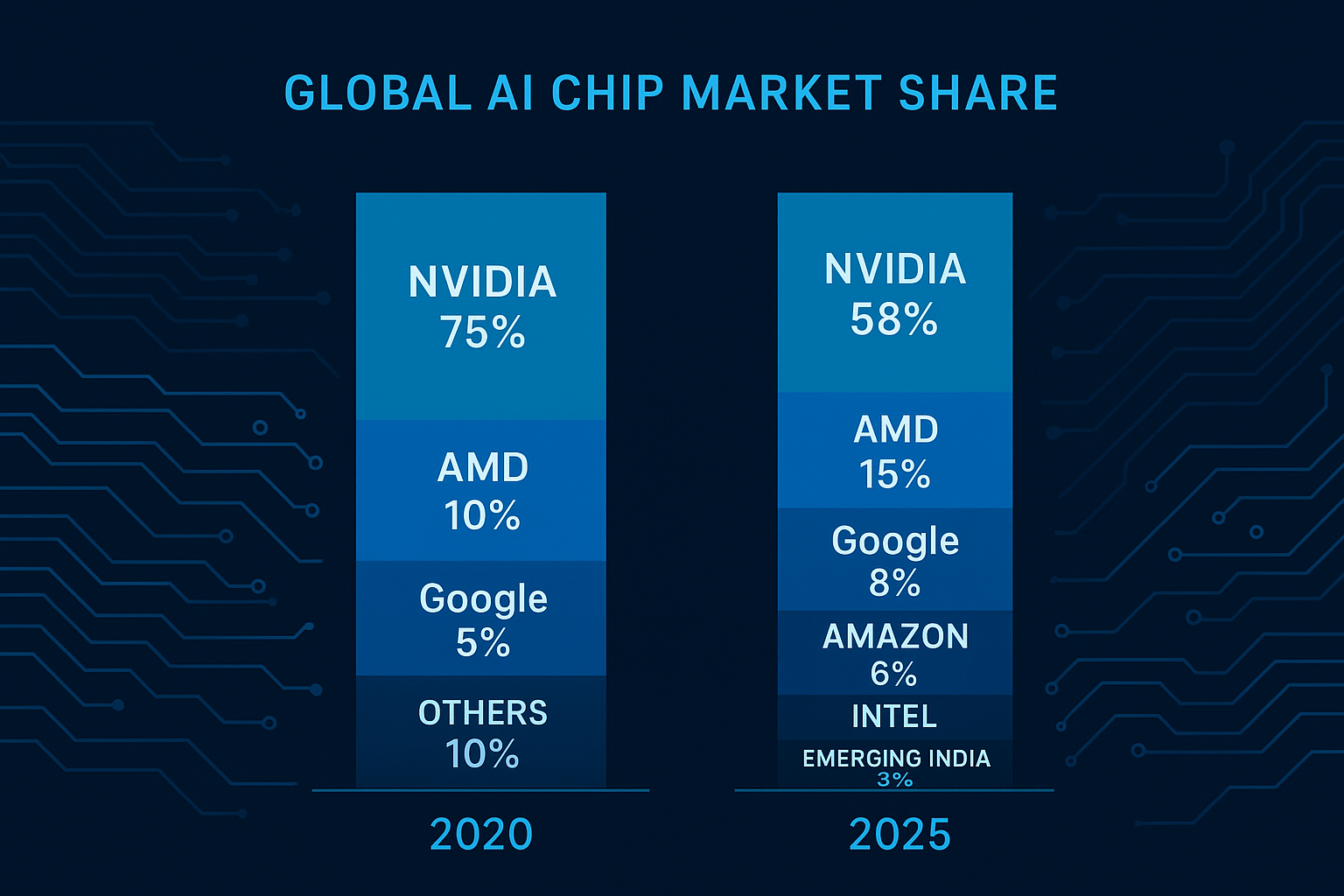🧠 Custom Silicon, AI Chips & the Infrastructure Arms Race: How India and the World Are Redefining Intelligence Itself
🌍 The New Gold Rush Isn’t Data — It’s Compute
In the early 2010s, the world realized that data was the new oil. By the mid-2020s, that slogan evolved: compute is the new currency. Every leap in AI — from GPT-4 to Gemini, from Claude to Mistral — has been powered not merely by clever algorithms but by the silicon beneath them.
Behind every chatbot and every autonomous car sits an invisible empire of AI chips — GPUs, TPUs, and custom accelerators — fueling an arms race among nations and tech giants. From California’s fabless chip corridors to India’s emerging semiconductor clusters, the race for artificial intelligence has become the race for infrastructure itself.
⚙️ Why Custom Silicon Matters
Generic hardware can’t keep up with the demands of AI models that span hundreds of billions of parameters. That’s why major players — NVIDIA, AMD, Intel, and now even Amazon and Tesla — are all moving toward custom silicon.
Custom silicon is engineered for one specific purpose: making neural networks faster, cheaper, and more energy-efficient. Instead of CPUs designed to do a little bit of everything, custom AI chips perform a few operations at massive scale.
NVIDIA’s Hopper and Blackwell GPUs dominate training workloads.
Google’s TPUs focus on efficiency and inference.
Amazon’s Trainium and Inferentia chips target cloud-scale scalability.
Tesla’s Dojo accelerates real-world vision AI for self-driving.
Apple’s Neural Engine optimizes on-device intelligence in every iPhone.
“The next trillion-dollar companies will be built not on AI models, but on the chips that make those models possible.” — Wired, 2025
⚡ The Global Compute Divide
The AI boom has exposed a global compute divide — the gap between nations that can build or access top-tier AI infrastructure and those that cannot.
The United States currently holds a massive advantage, hosting over 65% of the world’s AI supercomputing capacity. China follows closely, with deep state-backed investment in domestic GPU production. The European Union has launched its own sovereignty program, and the Middle East — led by the UAE and Saudi Arabia — is rapidly buying up NVIDIA hardware for its own AI ecosystems.
But perhaps the most quietly ambitious player in this race is India.
India’s Silicon Awakening
India’s AI revolution isn’t just about software anymore. With the launch of the Semicon India Initiative, the government has made clear that it wants to move from a consumer of chips to a producer.
Key projects shaping this transition include:
Tata–AMD Semiconductor Plant (Gujarat): India’s first advanced chip assembly facility, supporting AI hardware design.
C-DAC’s AIRAWAT Supercomputer: an AI-focused computing cluster powering national R&D in language models, healthcare, and defense.
IIT-Madras “Shakti” and “RISC-V Vega” Programs: open-source chip design ecosystems fostering indigenous hardware talent.
Saankhya Labs & Signalchip: home-grown startups building 5G and edge-AI processors.
India’s growing data infrastructure — from Jio’s edge AI networks to ISRO’s AI-driven satellites — signals that the country is not content to merely run AI; it wants to manufacture the intelligence itself.
“For the first time, we’re not just training on foreign hardware — we’re designing it.” — Amitabh Kant, India AI Mission, 2025
💥 The Infrastructure Arms Race
The race to build the fastest AI chip isn’t just corporate — it’s geopolitical. Governments are weaponizing compute as a strategic resource.
The US CHIPS Act injects billions to bring semiconductor manufacturing back onshore.
China’s SMIC and Huawei Ascend series push forward under heavy export restrictions.
Europe’s IPCEI program focuses on green AI hardware and quantum-ready chips.
India’s Semicon Vision 2047 aligns chip manufacturing with national AI goals.
This arms race extends beyond speed — it’s about control. The nation that controls the AI compute supply chain controls the next phase of digital power.

🔬 The Physics of Intelligence
Modern AI hardware is redefining the limits of physics itself. We are now stacking 3D chiplets, liquid-cooling GPU racks, and building optical interconnects that transmit photons instead of electrons.
Meanwhile, startups like Lightmatter and Celestial AI are building photonic processors that use light to compute — promising orders of magnitude faster performance with lower heat.
And beyond silicon lies the next frontier: quantum accelerators. IBM, Google, and startups like QpiAI (India) are exploring hybrid architectures that blend classical silicon with quantum logic gates — a potential revolution for machine learning efficiency.
🧠 Conclusion: The New Frontier of Power
This decade won’t be remembered just for AI models — it’ll be remembered for the machines that made them possible.
In a few years, nations won’t just compete over data or code — they’ll compete over electrons. Custom silicon is no longer just an engineering feat; it’s the new axis of intelligence, the invisible battlefield shaping tomorrow’s innovation, economy, and sovereignty.
And whether it’s a GPU farm in Texas, a fab in Gujarat, or a quantum lab in Tokyo — the next great leap in human progress will begin where intelligence meets infrastructure.
